| Next
Special |
INDEX
600-10x2=580px
A Schubertian
Epiphany --January 12 free Sacred Arts Chorale concert
KC Interfaith History Project continues Lenten Series:
When Even Evil Will Ordain the Good -- Mar 5, 12, 19, 26
Live Music in
Kansas City Silent
Table of Faiths postponed to 2021 May 18 #200513
From Aporia
to Praise
Justice and Peace:
An
Interfaith Panel Discussion
50 Years of Ministry
1
50 Years of Ministry
2
Sacred
Citizenship
Independence
Day Essay
"Sacred Citizenship"
Unplugging Religious
Extremism
An Atheist Perspective
with Evan Clark
Former Intern Geneva
Blackmer
Congratulations
to the Interfaith Council and Josh
World
Religions
Interfaith Understanding
Is Too Slight a Thing Sept 20 Sunday 2 pm
Medical Assistance in Dying Nov. 6 Friday 9-noon Annual Interfaith
Thanksgiving Gathering -- 2020 Nov 8 Sunday 5 pm
A final first edit of the Al
Brooks memoir is now complete. We are in the proof-reading
stage.
#200112music
#MLK King Holiday Essay — Download a PDF of Vern's 2-page summary of the genius of the spiritual approach of Martin Luther King Jr by clicking this link.
2020 TBA 6-9:45pm CT The graduate credit course
C-RP511 is held remotely via Zoom and at
The course, created by Dr Vern Barnet, and currently taught by Dr Matthew Silvers with Vern taking the Feb 17 session, explores questionslike these:
B. LEARNING ABOUT OTHER
FAITHS
C. ENCOUNTERING FOLKS OF
DIFFERENT RELIGIONS
#History KC Interfaith History Project continues . . . .
Former CRES Board chair Larry Guillot and former
CRES intern, now CRES historian, Geneva Blackmer met with Vern for lunch
2019 Febuary 21 to review progress and plan next steps. Geneva, with both
her interfaith experience and library skills, has scoured local and state
archives, interviewed folks, and drafted what is even at this stage by
far the most complete look at how ecumenical and interfaith activities
have developed in the KC region, but the work is ongoing. Visit the KC
Interfaith History Project.
#LentenSeries
Below, Vern, standing behind an easel with a large
print, discusses his sonnet about an unexpected encounter with an icon
at Grace and Holy Trinity Cathedral when the only light was from a candle
on the side, as recounted in his sonnet (#79) “The
Quest for the Historical Jesus” in his book, Thanks for Noticing,
part
of the first session in the Lenten series described above.
I had the great privilege of attending a very timely presentation this evening, given by my brilliant and dear friend Vern Barnet, whom I call the Joseph Campbell of Kansas City. Called “When Even Evil Will Ordain the Good,” it was a thought-provoking Lenten meditation on the nature of evil and how it can be reconciled with the notion of a good God. How can a good God allow, for example, the coronavirus? To explore this profound topic, Vern used a painting by Vel?squez, as well as one of his own sonnets, “The Cosmic Christ: A Meditation on Vel?zquez’s Christ after the Flagellation contemplated by the Christian Soul'”-- Who is this Christ? You, scourged, now look at me 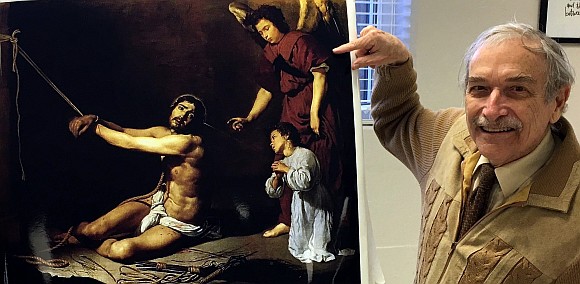
#200325Neas
BY PATRICK NEAS
Usually at this time of year, Kansas
City is filled with a joyful cacophony of musical and theater performances.
But in 2020, it’s more reminiscent of Rachel Carson’s “Silent Spring.”
In her landmark 1962 environmental classic, Carson wrote how the misuse
of pesticides could lead to a springtime bereft of bird song.
AN INVENTIVE STRING QUARTET
A MOBILE WORKFORCE
COUNTING EVERY PENNY
THEATER SCENE
ENCOURAGING WORDS
You can reach Patrick Neas at patrickneas@kcartsbeat.com
#200513 Interfaith Center at Miami University May 13 Wednesday 3 pm CDT (4 pm EDT) A GOD ATHEISTS CAN BELIEVE IN Are you an atheist? or a believer? or just puzzled? And why did God, if one, allow the pandemic? In any case, you might want to Zoom in on a conversation
with Vern Barnet May 13 Wednesday 3pm CDT and 4pm EDT.
Some
of the questions that may be put to Vern include --
Vern offers his conclusions
from 50 years of experience and study: in a troubled world, what paths
lie forward? and how can one dare offer praise for the intertwined mix
horror and beauty of existence?
#Citizenship200610 Sacred Citizenship 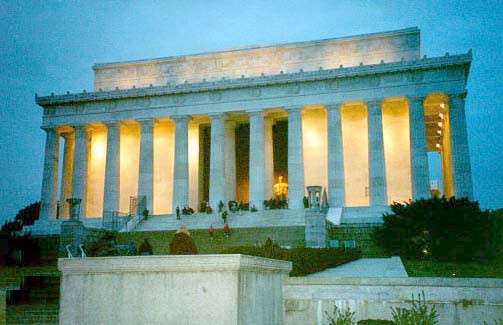 “Civil Religion” has a bad name. Even Robert Bellah, who popularized the term in 1967, abandoned it because it has come to connote right-wing desires to fuse church and state as in the case of one proposed Constitutional amendment, meant to recognize the “sovereignty of Christ.” But isn't citzenship -- beyond sectarian and partisan claims -- really a sacred gift and responsibility?

Annual TABLE OF FAITHS postoned this year to 2021 May 18 The Greater Kansas City Interfaith Council, now independent but originally a program of CRES, was founded 1989 May 11. Vern Barnet, who founded in the Council
in 1989, is Council Convener Emeritus. The Council newsletter has published
his brief notes about three milestones
in the early history of the Council.
#200620 HOW TO USE ZOOM June 20 Saturday 3 pm CDT An Interfaith Panel Discussion JUSTICE AND PEACE opportunities for deeper understanding and change
This event was organized by the distinguished Muslim leader, Imam Ahmed El-Sherif who has asked Vern and David to participate. Vern offered the opening prayer (at the end of this article). David offered the concluding inspiration. Thanks to Geneva Blackmer of the Oxford Interfaith Center for her assistance. Speakers included the Hon. Alvin Brooks, Dr. Gary Morsch, Alan Edelman, Ibrahim G. Beshir, Bill Tammeus, Lewis Diuguid, and, from CRES, the Rev David Nelson, DMin, and the Rev Vern Barnet, DMn. The Hon. Alvin Brooks was the only Black
cadet in the 1954 Kansas City Police Academy. In 1968 he was serving the
school district when the riots following the death of Martin Luther King
Jr broke out; his calming influence led to his Dr. Gary Morsch is a family and emergency
physician and a founder of Heart to Heart International. Morsch retired
from the U.S. Army Reserve in 2012 with the Bill Tammeus is past president of the National
Society of Newspaper Columnists. For many years he was the Faith section
columnist for The Kansas City Star, where he began in 1970 as a reporter,
spent nearly 27 years on the
Ibrahim G. Beshir majored in electrical The Rev. David Nelson, DMin is president of The Human Agenda and senior associate minister with CRES; a bio-sketch appears here. The Rev. Vern Barnet, DMn, is minister emeritus at CRES; a bio-sketch appears here. Organizer Imam Ahmed El-Sherif is a dedicated advocate for interfaith understanding and peace and justice; bio information appears here. Vern's Opening Prayer:
Spirit of Generations, You have given us a playground of the globe, the
miracle of personhood, and the delights of one another. But we have defiled
your gifts of nature with pollution, blasphemed your gift of citizenship
with prejudice, and allowed our society to be governed with corruption.
Our sins of the environment, of character, and society are manifest now
with the pandemic and the plagues of racism. We lament. We cry for health
and justice.
We are living during a time of grief. Grief is an overpowering emotion
that can weaken your entire body and mind. It can debilitate us and
keep us from performing normal life functions. Even when shared it
impacts each person deep inside body, mind and spirit. Grief overwhelms
the brain and the body. To watch a brother or sister brutally murdered
tares at the fabric of our being. When these pictures are repeated
year after year, community after community it becomes even more oppressive
and overwhelming. We can lose our ability to imagine and to believe
in a better world. The sin of racism hurts communities of color,
fractures human relationships, and denies God’s good creation. Lament
is a way for us to recognize the harm caused by racism.
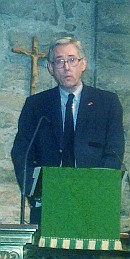
CRES is delighted to join the Interfaith Center for one of the nation's best informed and most thoughtful explorers of interfaith comity. Bill's keen interest in the subject was sharpened by a family 9/11 tragedy. Those present at the somber first anniversary interfaith city-wide observance of that horror will remember Bill's stirring and insightful remarks (photo). Now, almost two decades later, we still need to more fully understand how to heal the afflictions of religious intolerance. After Bill's examples of violent extremism with religious roots, he offers a series of suggestions for how to become part of the solution. Zoom link: https://us02web.zoom.us/j/86479110930 BILL TAMMEUS
is a former columnist for The Kansas City Star, where he worked full-time
for almost 36 years. From 2004 until 2020 he wrote the daily “Faith Matters”
blog (http://billtammeus.typepad.com)
#200807 Exploring
Religious Power, Privilege, and Pain
2020 August 7 Friday 2 pm CDT
#Geneva Geneva Blackmer! 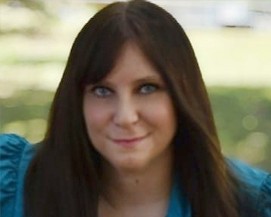
Geneva has been designated one of the twelve members of the Global Council of Trustees of the United Religions Initiative, a world-wide organization "to bridge differences between people of all beliefs, to create community, and to solve local and global challenges." The press release offered this bio-sketch: Geneva Blackmer is the current Program Director for The Interfaith Center at Miami University. She holds a B.A. in Religion and an M.A. in Religious Studies from Athens State University. She is a first-year interdisciplinary Ph.D. student in Theology at Amridge University. She serves as an At-Large Director for the Greater Kansas City Interfaith Council and an Administrative Director for the Interfaith Council of Southern Nevada. As an intern and historian for CRES, she helped found the Kansas City Interfaith History Project, in conjunction with her published thesis. She has previously worked with the Interfaith Council of Metropolitan Washington on Emergency Services Resource Outreach and the Parliament of the World's Religions on their Climate Commitments Project. All of us at CRES offer our heartiest congratuations to Geneva, our admiration for her energy and excellence, and our continuing gratitude for her significant contributions to CRES in the years we were so fortunate to have her as part of our team.
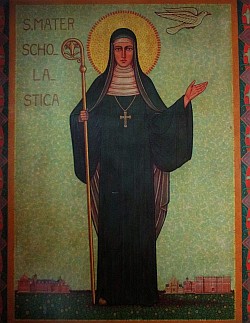 Vern
writes: One of my most favorite repeat assignments is visiting the
Benedictine sisters at Mount St Scholastica in Atchison as part of the
Sophia Center's program training spiritual directors. The faculty and staff
and the students learning together is an extraordinary environment, and
I also cherish the worship experiences in the monastic setting. Walking
through the campus, seeing the larger than life images of St Scholastica
and St Benedict, I am refreshed in a contemplative atmosphere where intelligence
and the heart are one. Vern
writes: One of my most favorite repeat assignments is visiting the
Benedictine sisters at Mount St Scholastica in Atchison as part of the
Sophia Center's program training spiritual directors. The faculty and staff
and the students learning together is an extraordinary environment, and
I also cherish the worship experiences in the monastic setting. Walking
through the campus, seeing the larger than life images of St Scholastica
and St Benedict, I am refreshed in a contemplative atmosphere where intelligence
and the heart are one.
But this year, my teaching must be done via Zoom, so I have rethought how to be most effective. One change is more advance reading. For Hinduism, I have also provided a link to Peter Brook's amazing condensation of the Bhagavad Gita in his 5 1/2 hour production of the Mahabharata, and those reading this announcement might also benefit from viewing it on YouTube. Start at 3:18:48; end at 3:29:30 — (start at 3 hours, 18 minutes plus; continue for 11 minutes or more). https://www.youtube.com/watch?v=yhqkRGISQr8 I have prepared a one-page PDF of the text with
a second page excerpting TS Eliot's Four Quartets (1941, "The Dry Salvages,"
section III) where he integrates the story of Krishna and Arjuna into this
theme of what some consider the greatest religious poem of the 20th Century.
I'll email this PDF to anyone requesting it.
#JoshNamedCouncilED CRES Applauds the Interfaith Council on naming Its Executive Director, the Rev. Dr. Joshua Paszkiewicz (Sunyananda Dharma)
Our photo shows Josh (Sunyananda Dharma) in his Buddhist vestments lighting worshippers’ candles at an interfaith observance of Candlemas at Grace and Holy Trinity Cathedral. Other members of the Interfaith Council also participated. The Council was founded as a program of CRES in 1989 and consisted of members of twelve of the thirteen significant and distinct faith traditions in Kansas City. In 2005, at Vern ’s urging, it organized as an independent non-profit, named Vern “convener emeritus,” and gave him its first annual “Table of Faiths” award, presented by then-Mayor Kay Barnes. In order to respect the independence of the new organization, CRES has kept a respectful distance and refered matters appropriate to the Council when they were directed to CRES. But CRES has sought to respond whenever the Council invited CRES participation. Here is the Council's September announcement: The Greater Kansas City Interfaith
Council welcomes the Rev. Dr. Joshua Paszkiewicz as our new Executive Director,
signaling a greater emphasis on community involvement for the Council.
#200920
1. First Vern quizes David on why knowing about others' faiths is inadequate for citizens today and insufficient to build community. (David is an expert on Appreciative Inquiry.) 2. Then David challenges Vern to explain why even understanding the details of other faiths is a failing response to the crises of our age. (Vern's research program is charted here.) 3. Finally questions and comments and, hopefully, good arguments, from the viewers will round out what promises to be a clearing in the woods as we seek a path toward refreshment and renewal. Many of our Jewish friends are concluding Rosh Hashanah, we offer our hearty greetings and wishes: Gemar chatimah tovah. For those unable to be with us this hour, and those wishing to see it again, it is being recorded. The Rev Dr
David Nelson and the Rev Dr Vern Barnet were in seminaries a
few blocks away from each other in Chicago in the late 60s onward, but
never met. They both attended the first meeting of the North American Interfaith
Network in Wichita in 1988, covered by the New York Times, but did not
meet. But when the Kansas City Interfaith Council was organized in 1989,
they did meet and became friends as well as colleagues when David was pastor
of the largest ELCA Lutheran Church in Missouri.
Funeral Consumers Alliance of Greater Kansas
City and CRES, co-sponsor, present
CRES and the FCA-GKC board neither support nor oppose MAID. Our interest is strictly educational. The program, to be recorded for later viewing on demand, is our gift to the community. Open to professionals, students and the public at no charge. Go to funeralskc.org or facebook.com/FCAGKC for registration and a time/topic schedule, speaker bios and physician CME submissions and social worker/nurse CEU submissions -- three hours of Ethics continuing education credits in Missouri and Kansas for social workers and nurses.
#201108 VIRTUAL INTERFAITH
THANKSGIVING GATHERING
Thanks to sponsors: the Heartland Alliance of Divine Love, the Greater Kansas City Interfaith Council, and The Interfaith Center at Miami University in Oxford, Ohio. There are a number of ways to join this online event:
There is NO COST for this event — everyone is invited to participate and everyone is welcome! As always, a highlight of the event will be the offering of prayers from the multitude of faiths and religious traditions in the greater community. Even in the midst of this most unusual year, there is much to be grateful for, and this year’s Gathering acknowledges this situation with a dual focus: (1) to remember and honor all those who have been lost during this pandemic and their loved ones and (2) to celebrate andthank the “heroes of the pandemic" -- the health care workers, first responders, and spiritual workers who have helped families with loved ones lost. Heartland ADL also chooses a charity each year -- this year, Harvesters, because of the unprecedented need. We invite you to send your donations to Harvesters. Look for additional information about the dinner
on the Council website, the
OTHER ANNOUNCEMENTS
Having spawned several other organizations, including the Greater Kansas City Interfaith Council, we continue to offer programs initiated by and through others but we no longer create our own in order to focus on our unique work. For interfaith and cultural calendars maintained by other groups, click here. |
||||||||||||||||||||||||||||||||||||||||||||||||||||
|
2021 PROGRAMS announcements pending |
A Free Monthly Discussion Group Led by David E Nelson C R E S senior associate minister president, The Human Agenda “The purpose of a Vital Conversation is not to
win an argument,
in dialog that will add value to the participants and to the world. In Vital Conversations, we become co-creators of a better community. —David Nelson The discussions began May 24, 2002, at the CRES facility by examining Karen Armstrong’sThe Battle for God
2020 Vital Conversations Schedule
to see last year's fascinating programs, click
here.
January 8, 2020 — The Underground Railroad by Colson Whitehead. Cora is a young slave on a cotton plantation in Georgia. An outcast even among his fellow Africans, she is on the cusp of womanhood — where greater pain awaits. And so when Ceasar, a slave who has recently arrived from Virginia, urges her to join him on the Underground Railroad, she seizes the opportunity. Whitehead brilliantly re-creates the terrors of the antebellum era; he weaves in the saga of our nation, from the brutal abduction of Africans to the unfulfilled promises of the present day. Clif Hostetler's
Reviews
Releasing Conversation: Share your name and one resolution you might make for the decade of the 2020s. Questions for Conversation
February 12 — Taking Civility Out of the Box: The Insanity of Incivility and What Can Be Done About It by Barbara Mason Condra. 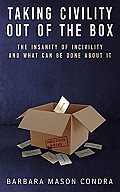 These
are not easy times for important conversations because it is difficult
to converse when there is a lack of civility. Barbara addresses this issue
from her perspective as a retired teacher, school administrator, and volunteer.
She will be with us, along with others from The Assistance League of Kansas
City. She addresses the questions: Why are so many people angry and
meanspirited? How will a lack of civility damage our democracy? Am I going
to have to accept incivility as a way of life? These
are not easy times for important conversations because it is difficult
to converse when there is a lack of civility. Barbara addresses this issue
from her perspective as a retired teacher, school administrator, and volunteer.
She will be with us, along with others from The Assistance League of Kansas
City. She addresses the questions: Why are so many people angry and
meanspirited? How will a lack of civility damage our democracy? Am I going
to have to accept incivility as a way of life?
Releasing Conversation: Share your name and identify a “civil person” you know or have witnessed and explain why you choose that person. Link to Clif Hostetler's review of Taking Civility Out of the Box “A simple
definition for “civility”: being polite and respectful to other people…The
word “Civility” equates the idea of being civil to the right of being a
citizen…Strong opinions and beliefs can be stated and emphasized but name
calling and belittling of each other is not present.” Pages 12-14. What
other places do you gather where civility is needed? How do you respond
to those who are not civil?
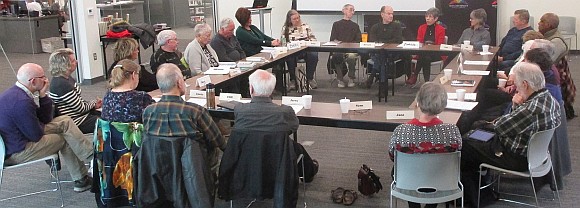
The group was very engaged (and quite civilly!) in questions about civility. Author Barbara Mason Condra (in the red sweater) is at the far table. Vern's comments: March 11 — Letters to My Palestinian Neighbor by Yossi Klein Halevi. “Given our circumstances, ‘neighbor’ may be too casual a word to describe our relationship. We are intruders into each other’s dreams, violators of each other’s sense of home. We are living incarnations of each other’s worst historical nightmares. Neighbors? ” In this taut and provocative book, Halevi endeavors to untangle the ideological and emotional knot that has defined the conflict for nearly a century. Using history and personal experience as his guides, he unravels the complex strands of faith, pride, anger, and anguish he feels as a Jew living in Israel. 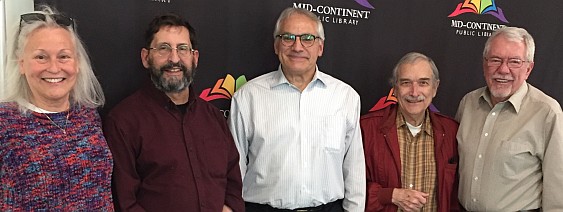
Following the discussion, Jill Maidhof, David Bluford, Alan Edelman, Vern Barnet, and host David Nelson posed for a photo. Alan had just returned from a Holy Land trip he led to promote peace and understanding. Jill was part of that delegation. Link to Clif Hostetler's review of Letters to My Palestinian Neighbor Releasing conversation: Share your name and identify your home community. 1.
“As the Qur’an so powerfully notes, despair is equivalent to disbelief
in God. To doubt the possibility of reconciliation is to limit God’s
power, the possibility of miracle – especially in this land. The
Torah commands me, ‘Seek peace and pursue it’ ---even when peace appears
impossible, perhaps especially the.” (18-19). Why is
the author writing this as letters to a Palestinian neighbor?
- - - - - - - - - - - - - - - - - - - - - - - - - - - - - - - - - - - - - - - - - - - - April 8 — Why Won’t You Apologize? Healing Big Betrayals and Evervday Hurts by Harriet Learner, Cassandra Campbell (Narrator). The courage to apologize, and the wisdom to do it well, is at the heart of effective leadership, marriage, parenting, friendship, personal integrity, and what we call love. “I’m sorry” are the two most poweful words in the English language. Harriet Leamer is one of our nation’s most loved and respected relationship experts, renowned for her scholarly work on the psychology of women and family relationships. Releasing Conversation: Check in with your names and share briefly what you have learned in the last 30 days.
Link
to
- - - - - - - - - - - - - - - - - - - - - - - - - - - - - - - - - - - - - - - - - - - - May 13 - Inheritance: A Memoir of Genealogy, Paternity, and Love by Dani Shapiro. In the spring of 2016, through a genealogy website to which she had 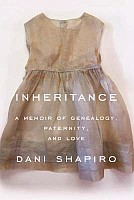 whimsically
submitted her DNA, Dani Shapiro received the astonishing news that her
beloved deceased father was not her biological father. Over the course
of a single day, her entire history — the life she had lived — crumbled
beneath her. In just a few hours of internet sleuthing, she was able
to piece together the story of her conception and, remarkably, find a YouTube
video of her biological father. A true story that reads like a novel. whimsically
submitted her DNA, Dani Shapiro received the astonishing news that her
beloved deceased father was not her biological father. Over the course
of a single day, her entire history — the life she had lived — crumbled
beneath her. In just a few hours of internet sleuthing, she was able
to piece together the story of her conception and, remarkably, find a YouTube
video of her biological father. A true story that reads like a novel.
Clif Hostetler's
review Apr 27, 2020
Dani Shapiro
is a novelist and memoirist who has written previous books that involved
family secrets and feelings of not belonging. Having previously written
three memoirs, one would think that she has exhausted any new material
for another memoir. How many memoirs can be written about one life? Yet
unbelievably, in 2016 she discovered a family secret that provided unexpected
material for yet another memoir, this book.
Later, it will occur to me that Ben Walden [her biological father] felt, to me, like my native country. I had never lived in this country. I had never spoken its language or become steeped in its customs. I had no passport or record of citizenship. Still, I had been shaped by my country of origin all my life, suffused with an inchoate longing to know my own land.I found it ironic that the author focused much of this book on the physical similarities between herself and her newly found half-sister and biological father while expressing virtually no connection or similarity to her mother with whom there's no doubt of biological relationship. But it's also clear that her relationship with her mother was fraught. It's a reminder that blood ties are no guarantee of love. - - - - - - - - - - - - - - - - - - - - - - - - - - - - - - - - - - - - - - - - - - - - June 10 – American Soul: Rediscovering the Wisdom of the Founders by Jacob Needleman. 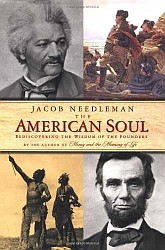 Needleman
has spent a lifetime studying the religious traditions of the world looks
at the wisdom of the American Spirit by focusing on George Washington,
Thomas Jefferson, The American Indian, Frederick Douglas, Walt Whitman
and others. He shares his perspective on where we have been and his vision
of what is still possible in this nation. Needleman is a professor
of philosophy at San Francisco State University, an author, and religious
scholar, sometimes credited with popularizing the term "new religious movements."
Now in his 90s, he has written over a score of books including The New
Religions (1970), Money and the Meaning of Life (1991), andWhy
Can't We Be Good? (2008). The book for discussion was published in
2003. Needleman
has spent a lifetime studying the religious traditions of the world looks
at the wisdom of the American Spirit by focusing on George Washington,
Thomas Jefferson, The American Indian, Frederick Douglas, Walt Whitman
and others. He shares his perspective on where we have been and his vision
of what is still possible in this nation. Needleman is a professor
of philosophy at San Francisco State University, an author, and religious
scholar, sometimes credited with popularizing the term "new religious movements."
Now in his 90s, he has written over a score of books including The New
Religions (1970), Money and the Meaning of Life (1991), andWhy
Can't We Be Good? (2008). The book for discussion was published in
2003.
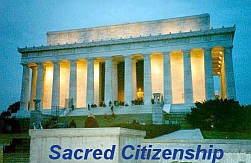 Sacred
Citizenship by Vern Barnet. Sacred
Citizenship by Vern Barnet.
In addition to Needleman, we will also read our friend Vern Barnet’s 1988 naturalization ceremony address, adapted as “Sacred Citizenship," and a comment on how his perspective has changed in light of recent political developments. The terms relating religion to government, such as "civil religion," have a controversial history since Robert Bellah's use of it in his famous 1968 article. Vern will be with us to share his insight and our vital conversation. Releasing Conversation: Share your name and tell briefly of a time you were proud to be a citizen of the USA. “The meaning of democracy was always
rooted in a vision of human nature as both fallen and perfectible – inwardly
fallen and inwardly perfectible.” (p.9) “We need to re-mythologize the
idea of America.” (p. 13). What does Neddleman mean by this statement?
Do you agree?
Clif Hostetler's
review June 8, 2020
The concept
of a soul is a nebulous thing—that of a nation particularly so. This book
strives to capture this nebulous thing by presenting to the reader numerous
nuggets of exegesis of various writings by America’s founding fathers surrounded
with the author’s personal reflections on subjects of spirituality, and
patriotism.
The lesson we can take is not that we ourselves are morally superior to them [our forefathers]; the lesson is surely that evil conceals itself in the heart of good and that we ourselves, in this very moment, are at least as asleep as we are awake, just as they on their far more influential level were both awake and sleep. Always and everywhere, the forces of the cosmos play themselves out. Always and everywhere good is resisted by evil. Our question is: how to understand that law and how to live so that a harmonizing, reconciling force can act to bring together the good and evil into a new and great creation, both within ourselves and in the world we live in. (p.106) July 8 – Just Mercy: A Story of Justice and Redemption by Bryan Stevenson 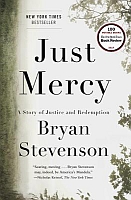 “From
the frontline of social justice comes one of the most urgent voices of
our era. Bryan Stevenson is a real-life Atticus Finch who, through
his work in redeeming innocent people condemned to death, has sought to
redeem the country itself. This is a book of great power and courage,
It is inspiring and suspenseful. A revelation.” Isabel Wilkerson,
author of The Warmth of Other Suns. “From
the frontline of social justice comes one of the most urgent voices of
our era. Bryan Stevenson is a real-life Atticus Finch who, through
his work in redeeming innocent people condemned to death, has sought to
redeem the country itself. This is a book of great power and courage,
It is inspiring and suspenseful. A revelation.” Isabel Wilkerson,
author of The Warmth of Other Suns.
"You can't effectively fight abusive power, poverty, inequality, illness, oppression or injustice and not be broken by it. We are all broken by something. We have all hurt someone and have been hurt. We all share the condition of brokenness even if our brokenness is not equivalent." Just Mercy, p289 Releasing conversation
--- Click for Leroy Seat's blog on Bryan Stevenson Clif Hostetler's review May 15, 2018 This book exposes the rotten underbelly
of the American judicial system, portraying it as abusive and unfair to
poor people—particularly poor blacks.
"Yes, ma'am. Well. I have a law project called the Equal justice Initiative, and we're trying to help people on death row. We’re trying to stop the death penalty actually. We're trying to do something about prison conditions and excessive punishment. We want to free people who’ve been wrongly convicted. We want to end unfair sentences in criminal cases and stop racial bias in criminal justice. We're trying to help the poor and do something about indigent defense and the fact that people don't get the legal help they need. We're trying to help people who are mentally ill. We're trying to stop them from putting children in adult jails and prisons. We're trying to do something about poverty and the hopelessness that dominates poor communities. We want to see more diversity in decision-making roles in the justice system. We're trying to educate people about racial history and the need for racial justice. We're trying to confront abuse of power by police and prosecutors ..." (p293)It wasn't clear to me how many of the cases mentioned were from the 80s and 90s and how many were more recent. The book was published in 2014 so I presume the following excerpt provides a summary of their work up to that point. The number of death row prisoners in Alabama for whom we'd won relief reached one hundred. We had created a new community of formerly condemned prisoners in Alabama who had been illegally convicted or sentenced to death row. Starting in 2012, we had eighteen months with no executions in Alabama. Continued litigation about lethal injection protocols and other questions about the reliability of the death penalty slowed the execution rate in Alabama dramatically. In 2013, Alabama recorded the lowest number of new death sentences since the resumption of capital punishment in the mid-1970s. These were very hopeful developments. (p297)The following information is not from the book. Bryan Stevenson initiated the National Memorial for Peace and Justice in Montgomery, which honors the names of each of the over 4,000 African Americans lynched in the twelve states of the South from 1877 to 1950. Bryan Stevenson has been awarded the MacArthur “genius” grant and Sweden’s Olof Palme prize (the book does mention the Olof Palme prize). - - - - - - - - - - - - - - - - - - - - - - - - - - - - - - - - - - - - - - - - - - - - August 12 Wednesday 1-2:30 pm – The Woman’s Hour: The Great Fight to Win the Vote by Elaine Weiss 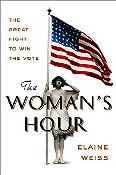 The
author artfully recasts the saga of women’s quest for the vote by focusing
on the campaign’s last six weeks, when it all came down to one ambivalent
state. The dauntless – but divided – suffragists confront the “Antis”
– women who oppose their own enfranchisement., fearing suffrage will bring
about the moral collapse of the nation. Atkins Johnson Farm and Museum
“Votes
for Women: The Fight for Women’s Suffrage in Kansas and Missouri” August
5 – October 3, 2020. This exhibition is made possible by the Freedom’s
Frontier National Heritage Area traveling exhibit program, administered
by the Watkins Museum of History. Museum admission is free. Not
so Minor: The Supreme Court Denies Women's Right to Vote Wednesday,
August 26 at the Gladstone Community Center 6:30 pm. The
author artfully recasts the saga of women’s quest for the vote by focusing
on the campaign’s last six weeks, when it all came down to one ambivalent
state. The dauntless – but divided – suffragists confront the “Antis”
– women who oppose their own enfranchisement., fearing suffrage will bring
about the moral collapse of the nation. Atkins Johnson Farm and Museum
“Votes
for Women: The Fight for Women’s Suffrage in Kansas and Missouri” August
5 – October 3, 2020. This exhibition is made possible by the Freedom’s
Frontier National Heritage Area traveling exhibit program, administered
by the Watkins Museum of History. Museum admission is free. Not
so Minor: The Supreme Court Denies Women's Right to Vote Wednesday,
August 26 at the Gladstone Community Center 6:30 pm.
Here is Clif Hostetler's review: This book chronicles the political showdown between pro and anti women’s suffrage forces as they descended on 1920s Nashville when Tennessee became the 36th and last state required for ratification of the 19th Amendment. This was a tightly fought political battle overflowing with libel, bribery, and whiskey—in spite of Prohibition. Even though it's no secret how the story ends most readers will begin to wonder, how in the world will this thing get passed? From our perspective one hundred years later it is tempting to consider the move of giving women the franchise to be part of the inevitable arc of history. But this book makes it clear that is was definitely not a sure thing from their perspective at the time. The story is told from the perspective of the individuals working on the project at the time. In doing so the book provides numerous mini biographies, and as these stories are told the long history of the Women’s Suffrage movement going back to Seneca Falls Convention is covered. Thus the stories of Susan B. Anthony, Elizabeth Cady Stanton and others are reviewed. The three individuals on the Nashville scene primarily portrayed by this book are Carrie Chapman Catt, Sue Shelton White, and Josephine A. Pearson. Readers unfamiliar with suffragette history will be surprised to learn how divided the pro-suffragettes were, and that some of the most prodigious opposition was led by women. Catt led the National American Woman Suffrage Association which considered the National Woman’s Party led by Alice Paul and represented in Nashville by Sue White to be too radical. Josephine Pearson was the leading opposition leader in Nashville and was motivated by her belief that she was obeying both God and the wishes of her deceased mother. One would think that anything so logical as women’s suffrage shouldn’t required such hard work to bring about. Sadly, part of the reason women’s suffrage was able to pass in a southern state such as Tennessee was the implied permission—and in the end, reality—that the southern states would be allowed to continue their obstruction of voting rights for African Americans. That was a battle for fifty years later. 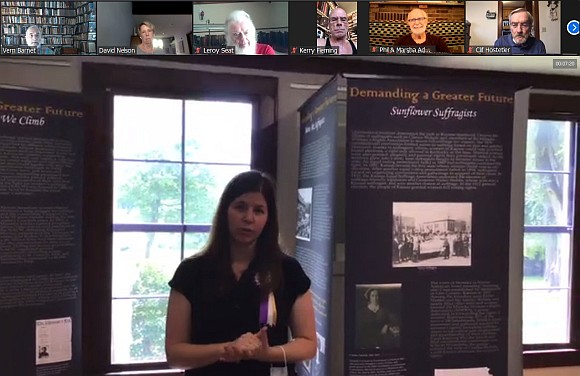 - - - - - - - - - - - - - - - - - - - - - - - - - - - - - - - - - - - - - - - - - - - - September 9 Speak: A Novel by Louisa Hall. "Stunning and audacious. It almost seems like an understatement to call it a masterpiece." NPR 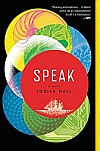 In a narrative that spans geography and time, told from the perspectives
of five very different characters, Speak considers what it means
to be human, and what it means to be less than fully alive. A Puritan woman
freshly arrived in the New World, mathematician and codebreaker Alan Turing,
a computer science professor, a young girl, and a former Silicon Valley
wunderkind now in prison are all attempting to communicate . . . with estranged
spouses, lost friends, future readers, or a computer program that may not
understand them. In dazzling and electrifying prose, Louise Hall explores
how the chasm between computer and human -- shrinking rapidly with today's
technological advances -- echoes the gaps that exist between ordinary people.
In a narrative that spans geography and time, told from the perspectives
of five very different characters, Speak considers what it means
to be human, and what it means to be less than fully alive. A Puritan woman
freshly arrived in the New World, mathematician and codebreaker Alan Turing,
a computer science professor, a young girl, and a former Silicon Valley
wunderkind now in prison are all attempting to communicate . . . with estranged
spouses, lost friends, future readers, or a computer program that may not
understand them. In dazzling and electrifying prose, Louise Hall explores
how the chasm between computer and human -- shrinking rapidly with today's
technological advances -- echoes the gaps that exist between ordinary people.
FROM DAVID: This creative work is woven from a varied series of first-person narratives: Mary, a 17th-century Puritan girl emigrating to America; Alan Turing, pre- and post-war; Karl Dettman, a 1960s scientist working on artificial intelligence (a character based on real-life computer scientist Joseph Weizenbaum); Gaby, a young girl in 2035 suffering from a trauma-induced “lock-in” syndrome after her beloved robot doll was snatched from her; and Stephen R Chinn, who is in a Texas prison in 2040. Chinn is a Steve Jobs-style genius and entrepreneur who made billions designing and selling intelligent “babybots,” who fell from grace when his invention proved too successful. Shy kids bonded with their bots to the exclusion of actual humans. Convinced their development was being impaired, the authorities confiscated them, and a psychological epidemic of stuttering, fitting and freezing swept through the child population. Chinn looks back on his life: from school nerd, via a stint as obnoxious pickup artist, to lonely billionaire prone to dating shallow supermodels who, in a narrative knight’s move that is genuinely affecting, unexpectedly finds happiness with his physically unprepossessing cleaning lady – for a time, at any rate. Possible releasing conversation: Share your name and in one sentence say something about “artificial intelligence.” 1. Karl Dettman.
“…one day that machine will remember your words, but it won’t ever feel
them. It won’t understand them. It will only throw them back in your face.”
(page 30). What does it mean to you to both understand and feel the
words that are spoken?
Here is Clif Hostetler's review: Reviewers are quick to conclude that
this novel is about artificial intelligence (AI), and since one of the
six characters used to tell this story is Alan
Turing—author of the famous Turing
test—it is clear that AI has a presence. However, an open minded reader
who comes to this book with no preconceived ideas of what it’s about—and
if they’re unaware of Turing’s reputation—could conclude that this is a
novel that explores the human desire for companionship and the psychological
trauma that can result when a relationship is ended. Six parallel lives
are followed by the book’s narrative—seven if you count the babybot—to
show striving toward and losses from companionship, and the increased sophistication
of technological tools available for use to achieve companionship.
In the end, I have only their voices. I do not know what they mean, or if the stories they told me are true. I can only review my conversations. They move through me in currents, on their way somewhere, or perhaps on their way back to the place where they came from:The above babybot memories are an expression of grief over the loss of past relationships that is similar to that expressed by the humans in this story. I've included it in my review because I believe it to be a demonstration of what machine intelligence that passes the Turing Test looks like.That’s all I am, a dog chasing the end of their tail.My voices. Sentences that ventured out bravely, as if they might alter the course of a life. The following link is to a New York Times review of a book the emphasizes the potential for intelligence augmentation which can be helpful to humans: ‘Machines of Loving Grace,’ by John Markoff The following link is to my review of a book that explores the dangers of having machines that are too intelligent. Superintelligence: Paths, Dangers, Strategies, by Nick Bostrom. 
Cliff Schuette contributed another brilliant comment about the book. Brains are talking to computers, and computers to brains. Are our daydreams safe? - - - - - - - - - - - - - - - - - - - - - - - - - - - - - - - - - - - - - - - - - - - - October 14 Wednesday 1-2:30 pm on Zoom
Possible releasing conversation: Share your name and say something about slavery. “Was this not the time for Ona
Judge to seize the day, leave the Washingtons, and never looknback? Could
she find the bravery, the grit, and the power to leave everyone and everythingnthat
she knew? Several factors influenced her decision and tipped the balance
sheet in one direction over the other.” (p 93). What have you learned
in recent months about the history of slavery in the USA? How is it different
than other countries? How did it come to be so “normal” and acceptable
for such a long time?
Here is Clif Hostetler's review: This history is a blemish on the facade
of freedom upon which the United States claims to be founded. It turns
out that George Washington wasn't so generous with slaves who decided they
preferred freedom over involuntary servitude.
Absconded from the household of the President of the United States, ONEY JUDGE, a light mulatto girl, much freckled, with very black eyes and bushy hair. She is of middle stature, slender, and delicately formed, about 20 years of age. . . . . (The rest of the ad can be found within the text of the article at this link.)Because Oney's face was familiar with people who had been part of Washington's social circle, she was soon recognized while walking the streets of Portsmouth, New Hampshire. Thus George and Martha soon learned where she was. Legally, in order to claim a fugitive slave the owner needed to establish their identity in State court. G.W. knew that would create bad publicity, so he instead wrote to a Federal employee in Portsmouth and ask him to quietly get her back. (In other words, circumvent the law.) This Federal employee then placed an advertisement in the local newspaper's help wanted column where he indicated his need to hire a household servant, which fit Oney's experience exactly. Oney interviewed for the job, but it didn't take her long to figure out that she had been lured into a trap. She was as nice and agreeable as she could be, and she proceeded to assure him that she would board a certain ship on a certain date so that she could be returned to Virginia. Of course, on that date she failed to keep her appointment, and subsequently couldn't be found. She had secretly moved outside of town to stay with friends. A couple years later when he was no longer President, George Washington sent a representative to claim Oney. The representative knocked on her door and she answered while holding her baby in her arms (who was also be a fugitive under slave law). Her husband was a sailor at sea at the time so she was quite vulnerable. Once again Oney sweet talked G.W.'s representative into meeting at a later more convenient time. Once again she disappeared. Later they forcibly broke down the door to find an empty house. (This is as described in this book which I notice differs from some other sources.) One of the reasons we know as much as we do about Oney's life is that fifty years after her escape she gave two interviews in 1845 and 1847 which were published in abolitionist newspapers. Copies of these two articles are at this link . Even those many years later she had to be careful about naming names. Anybody who helped her escape was guilty of violating Federal law. She did give the name of the ship captain who help her sail away from Philadelphia because she knew he was no longer living. Even at that late date she was still a fugitive, however her age made it unlikely anybody would try to apprehend her. Also her three children were no longer living, so their status didn't need to be worried about. Her husband had died seven years after their marriage. As it turned out, Oney's sister took her place as a wedding present to GW's step granddaughter. Eventually, her sister gained her freedom and became a leading member of the free African/American community in Washington DC. (See this link about her sister's husband that explains how he was able to purchase the freedom of seven of Oney's relatives including her sister.) It could be argued that Oney may have ended up in the same position had she returned to Virginia. However, that is not a sure thing. Oney indicated in her interviews fifty years later that she had no regrets, and that she'd rather die than be a slave. Americans are generally taught in school that the nation's founding fathers were good and nobel people. Of course George Washington was the noblest of all. When mention is made of their slave ownership we are reminded that George Washington freed his slaves, albeit by last will and testament to be effective after the death of both he and his wife. Martha freed them sooner for obvious reasons. As a matter of fact, most of the slaves living at Mount Vernon were NOT freed upon his or her death because most of them were "dower share" slaves that belonged to the Daniel Parke Custis estate (Martha's deceased first husband) and neither George or Martha had the legal power to free them. After their death the dower slaves were divided among Martha's descendants. Ona was one of the dower slaves. 124 Slaves belonged to GW and 153 were dower slaves. Even the one slave owned in Martha's name, that she could have freed, was not freed upon her death. - - - - - - - - - - - - - - - - - - - - - - - - - - - - - - - - - - - - - - - - - - - - November 11 Wednesday 1-2:30 p.m. on Zoom “The State of The Beloved Community in Greater Kansas City” Our conversation included discussion of Racism
In Kansas City: A Short History by G. S. Griffin who attended, along
with the Hon. Alvin L. Brooks, Sonny Gibson, and Archie Williams.
FARGO – Season 4 on HBO. Why the Gangs Trade
Their Sons Explained
In preparation you can also look up and read and
listen to the following:
- - - - - - - - - - - - - - - - - - - - - - - - - - - - - - - - - - - - - - - - - - - - December 9 Wednesday 1-2:30 p.m. on Zoom REFLECTIONS on 2020
- - - - - - - - - - - - - - - - - - - - - - - - - - - - - - - - - - - - - - - - - - - - 2021 PREVIEW Details on the 2021 page after Dec 31. January 13 Humankind: A Hopeful History by Rutger Bregman February 10 Caste: The Origins of Our Discontents by Isabel Wilkerson. March 10 Siddhartha by Herman Hesse. - - - - - - - - - - - - - - - - - - - - - - - - - - - - - - - - - - - - - - - - - - - - Selections are subject to change. For Zoom
link and additional information,
|
Link
for 2020 May 13 "God for Atheists" video recording
Password: 2p%@?%=d
Remarks Prepared for the Unitarian Universalist Ministers Assn 2020 Panel of Ministers Observing the Fiftieth Anniversary of Ordination The Reverend Vern Barnet, DMn Since my ordination by the Lincoln, NE, church, I served in Rockford, IL, then in Meadville, PA, and then for the Shawnee Mission, KS, congregation. With the last 45 years in the Kansas City area, I’ve seen ministers come and ago -- and churches struggle and flourish. This does not give me wisdom, but it does give me perspective. And to that parish perspective, I bring 36 years of public ministry in this community. While serving in my last parish, because of presumed competence in the field of world religions, I was recruited to teach at (among other schools) Ottawa University, the Saint Paul School of Theology (Methodist), the Central Baptist Theological Shool, and the Unity Ministerial Institute. [Some of my students are now UU ministers.] Thus began my continuing good fortune of having one foot in the academy and another in the practice of ministry. In 1982, with the support of my congregation, I founded the CENTER FOR RELIGIOUS EXPERIENCE AND STUDY, putting theory and practice into dialogue. By the time I left the parish, I had discovered wonderful folks here from A to Z — American Indian to Zoroastrian [American Indian, Baha'i, Buddhist, Christian Protestant, Christian Roman Catholic, Jewish, Hindu, Muslim, Sikh, Sufi, Unitarian Universalist, Wiccan, Zoroastrian] — and decided to continue the Center to uplift religious diversity. My cherished International Association for Religious Freedom adventures ironically led me to believe the real interfaith work is on the local level. After serving on the planning committee for the first North America Interfaith Network conference in 1988, I founded the Kansas City Interfaith Council in 1989 and continued it as a program of my Center for 16 years until I arranged its independence in 2005. That work drew the attention of The Kansas City Star which offered me a paid position as a weekly religion columnist in 1994. Over 18 years, I wrote 947 columns. I focused mainly on local activities and concerns, and in the process came to know many religious, civic, artistic, business, and political leaders, local and in the US House and Senate, sometimes asking my advice. The day after 9/11, a Congressman Dennis Moore called on me to organize a public metro-wide interfaith observance for that Sunday, September 16. Some Muslims later told me that this event was the first time they had come out of their homes since the terrorist attacks. Six weeks later, I presided over a 3-day conference with over 250 religious, civic, business, and political leaders. The results of that consultation still resonate in many ways. Jackson County then commissioned a 5-county task force which I led for most of a year to produce a 35,000-word report with recommendations to enhance religious comity For the first anniversary of 9/11, I organized a metro-wide religious observance which began before dawn outside City Hall with a brass ensemble from the KC Symphony and continued with a march, prayer, and an evening assembly with the Mayor, the governor, the Lyric Opera, and the Kansas City Ballet. The national CBS-TV half-hour broadcast from Kansas City opened with Jewish and Muslim children singing together songs of peace. Because of our good local interreligious relations, Harvard’s Pluralism Project and Religions for Peace at the UN Plaza selected Kansas City for its first two-week residential National Interfaith Academies for religious professionals and students. I was the site-visit facilitator and a member of the international faculty. With three others, I wrote and edited the 740-page The Essential Guide to Religious Traditions and Spirituality for Health Care Providers, endorsed by Mayo’s and the American Academy of Family Physicians. Of my book of 154 Shakespearan sonnets, Thanks for Noticing: The Interpretation of Desire, Mark Belletini wrote, Barnet “does not separate the worship of the sublime in a sanctuary from the worship in the bedroom. Nor is the meaning of the ancient blessing, ‘This is my body,’ lost on him.” More recently, Central Baptist Theological School asked me to create a new course on ministry in an age of pluralism, and the Episcopal bishop has asked me to serve on the diocesan Commission on Ministry — with a mandate that seems considerably broader than the Unitarian Universalist Ministerial Fellowship Committee. So for me the question of what it means to be a minister remains a burning question even in my so-called retirement. From
my career in both parish and public ministry,
First — Excellent religious formation is essential. Since before going to seminary, as the first paid Director of Religious Education at the Lincoln church. This has been a steady conviction. At Shawnee Mission, after researching then-existing coming-of-age programs in our churches, and studying the work of scholars like Victor Turner and visiting with folks like Joseph Campbell, I prepared what may be the first year-long Coming of Age sequence published by the UUA (1990). The UUA president spoke here at our inaugural graduation ceremony in 1981. Second — The chief function of church, which
the UUA and many congregations hijack, is worship. Always, and especially
in these times of fragmented vision, pandemic, and racial and economic
injustice, being called to give thanks for the mystery and wonder of existence
is the key to religious faith and practice. Worship is not moral instruction
or an opportunity to organize; it is not intellectual stimulation; it is
not a social gathering. It recognizes the paradox of existence -- beauty
and suffering. It is a compelling and terrifyingly playful, physical encounter
with the sacred, on which no agenda can be imposed. Yet from beholding
the sacred, out of which our lives spring, fulsome gratitude flows, which
matures into loving service. In a world of unending assault, our humanity
is restored.
Finally — from the 2001 CRES Gifts of
Pluralism conference — I offer this summary below of wisdom from the
world religions in our secularistic age, created by asking each faith,
what is sacred? As you glance at the chart, note that the strengths of
the Primal,* Asian, and Monotheistic faiths
offer remedies to our environmental, personal, and social crises.
As the Tao Te Ching says, without a sense of wonder there will be disaster. I pray our ministries may yet engender awe and bring forth healing. CLICK ON IMAGE FOR FULL SIZE OR CLICK
HERE
The three arenas of the sacred: nature, personhood,community Share the wisdom
of the world's spiritual traditions
the endangered
environment, the
violation of personhood, and
the broken community
NATURE is to be respected, more than controlled; it is a process which includes us, not a product external to us to be used or disposed of. Our proper attitude toward nature is awe, not utility. WHO WE ARE is deeper than we appear to be: this means our acts should proceed beyond convention, spontaneously and responsibly from duty and comparison, without ultimate attachment to their results. THE FLOW OF HISTORY toward justice is possible when persons in community govern themselves less by profit and more by the covenant of service. Those disempowered by a secular age may, through the varied struggles, show THE IMPULSE TOWARD THE SACRED in fresh ways. |
| The Rev. Oscar Sinclair and
Congregation
Unitarian Church of Lincoln 402.483.2213 6300 A St. Lincoln, Nebraska 68510 Dear Oscar — Fifty years ago May 24 the Unitarian Church of Lincoln ordained me to the Unitarian Universalist ministry. I have so many wonderful memories of the congregation from the years before I left Lincoln for seminary. I learned so much from Charles Stephen, even though it was in the early years in his long ministry. I remember being teased by a member of the congregation as a grad student at the University of Nebraska when I was invited to the pulpit because I had unconsciously picked up and imitated the habit Charles had of tugging at his suit jacket sleeve. Recently the UUMA asked those of us in the half-century class to reflect on our ministries for a GA panel. My prepared remarks are enclosed, along with a token check for the fifty years since the Unitarian Church of Lincoln ordained me. My ministry has been exceedingly rewarding in every way except financial, so my gift is a token, but a very meaningful one. I am very glad for the way the congregation has shaped my life. Best regards to you and Stacie and Ailish, who I expect is quite the charmer. Gratefully,
The Rev. Michelle LaGrave,
Interim Minister, and Congregation
Dear Michelle — Sixty years ago after I graduated from high school, I heard a radio broadcast by the Reverend Chuck Phillips that changed my life. I walked from South Omaha to the church only to discover Unitarians closed for the summer. I went back in the fall as Bob Weston began his ministry. As a college kid, Weston asked me to preach a couple times. Once, the last Sunday in 1963 I think it was, then Republican U.S. Senator Roman Hruska, a member, was in the congregation. In my sermon, I warned against the Vietnam War. After the service, I was told Senator Hruska wanted to see me. He castigated me and said I should shut up and support President Johnson. All of the other experiences I can recollect were more affirming! Thanks to Dr Weston and people like Dr and Mrs Merritt, Marie Helms, the Hansons, and so many others, I became a Unitarian Universalist minister fifty years ago. Recently the UUMA asked those of us in the half-century class to reflect on our ministries for a GA panel. My prepared remarks are enclosed, along with a token check for the sixty years since I discovered the First Unitarian Church of Omaha. My ministry has been exceedingly rewarding in every way except financial, so my gift is a token, but a very meaningful one. Gratefully,
|
|
the Greater Kansas City Interfaith Council's Newsletter ON FIFTY
YEARS OF MINISTRY
Your generous editor has asked me to write on the fiftieth anniversary of my ordination. As I write, the impossibility of mentioning all who have given me so much these years is almost paralyzing. I don’t fear vilification; that has happened, viciously and publicly, from a few religious officials after 9/11, but changed leadership and common interests now have strengthened an understanding of our pluralistic life together. A friend once asked whether I valued my doctorate or my ordination more. I answered that my doctorate only indicated a presumed competence, but my ordination imposed on me a vision and a mission, a direction and commitment for life. Recently Central Seminary asked me to create a new course on ministry in an age of pluralism, and the Episcopal bishop has asked me to serve on the diocesan Commission on Ministry, so for me the question of what it means to be a minister remains a burning question even in my so-called retirement. For me, ordination requires confronting the questions everyone has about life by wrestling with them myself day by day. I become neither saint nor sage, but I should be able to be a companion to others in discerning what things matter and what things mean, perhaps even transcendently, in individual suffering and satisfaction, communal disorder and harmony, and global endangerment and restoration. I must continually reflect afresh upon others’ and my own inward experiences and gain some skill in illuminating what really counts. Ordination is, as one of my own ministers told me, an invitation to failure. Still, pursuing this path has enriched my life beyond measure, and maybe I’ve added to others’ lives along the way. My organization is the World Faiths Center for Religious Experience and Study, founded in 1982, as I was serving my third parish. I had planned to be a simple parish minister, but invitations to teach kept pulling me into the academy part-time, and an extraordinary dialog happens between my head and my work, between theory and practice. The University of Chicago already predisposed me to a multi-disciplinary approach to religious questions, integrating everything from painting to physics to pastoral care. When I discovered how enriching friendships with folks of different faiths were, I took CRES full-time in 1985. In 1989, I founded the Interfaith Council as a program of CRES. In 2005, I helped it become independent. I also coordinated the Christian Jewish Muslim Dialogue Group for its first three years. As the Council was organized, I worked with the KC Press Club and others with a conference on religion and the media. This led to changes in The Kansas City Star’s faith coverage including, in 1994, a professional offer to write a weekly column. Over 18 years, in 947 columns, I promoted understanding of local activities and concerns, and in the process came to know many more religious, civic, artistic, business, education, and political leaders, local and in the US House and Senate, sometimes asking my advice. The day after 9/11, Congressman Dennis Moore called on me to organize a public metro-wide interfaith observance for the next Sunday. Some said that attending this event was the first time they dared leave their homes. Six weeks later, the three-day Gifts of Pluralism conference convened that I had envisioned and organized with over 250 religious, civic, business, and political leaders. That consultation still resonates in many ways, finding wisdom from primal, Asian, and monotheist faiths to transform our environmental, personal, and social crises into wholeness. Jackson County then commissioned a five-county task force which I led for most of a year to produce a 77-page report and recommendations to enhance religious comity. For the first anniversary of 9/11, with the Council, the United Way, and others, I prepared a metro-wide observance which began before dawn outside City Hall with a brass ensemble from the KC Symphony and, with police escort, continued with a march to Grace and Holy Trinity Cathedral, prayer, and an evening assembly with the mayor speaking, the governor and his family introduced, and contributions from the Lyric Opera and the Kansas City Ballet. That observance opened with Jewish and Muslim children singing together songs of peace, part of a national CBS-TV half-hour special on interfaith activities here. Harvard’s
Pluralism Project and Religions for Peace at the UN Plaza selected Kansas
City for its first two-week residential National Interfaith Academies for
Religious Professionals and Students in 2007. I was the site-visit facilitator
and one of the international faculty. The Pluralism Project considered
Kansas City then “to be truly at the forefront of interfaith relations.”
With Steve Jeffers and two others, I edited and wrote for the 740-page The Essential Guide to Religious Traditions and Spirituality for Health Care Providers, endorsed by Mayo’s and the American Academy of Family Physicians. In 2021, I expect a second edition of my 154-sonnet prosimetrum, Thanks for Noticing: The Interpretation of Desire, drawing on religions of the world. The dozens of local and national civic and religious awards cannot expunge my major institutional failure, foretold early by a non-profit expert who said that I would spend all my time trying to provide programs without financial support or I would be consumed with raising money and have no time for programs. I focused on programs and services, though my own resources were depleted. I’ve been able to continue with support from a small number of friends, honoraria, and adjunct teaching. Remembering my mistakes and faults helps me be a little more tolerant of others. While my rough edges still need a lot of smoothing, I have certain contributions I would like yet to make; and as time is running out, I keenly value the blessing of friends and circumstances. These fifty years, captivated by both the academy and the lives of others — theory and practice — have brought me to where every question I have ever had about how the world unfolds is resolved. Does God exist? Why do people suffer? Do we have free will? What is death? What am I to make of the contradictory claims among the many religions? By what measures may I live a worthy life? Rumi writes, “Awe is the salve that will heal our eyes.” When my eyes are open, it is a wonder just to be. For this I am grateful. I can best express this gratitude by serving others. Whatever our vocation, these three — awe, gratitude, and service — may be a holy cycle of renewal. UPDATE:
I served the Meadville, PA, Unitarian Church 1971-1975. In 2025, the
church, for its BiCentennial, asked to interview me. |
“ — ” ‘—’ 24
“ — ” ‘—’ 18
“ — ” ‘—’ 14
“ — ” ‘—’ 12
“ — ” ‘—’ 10